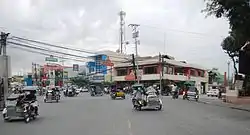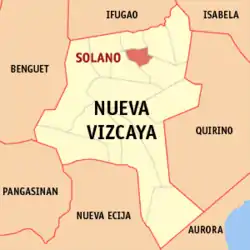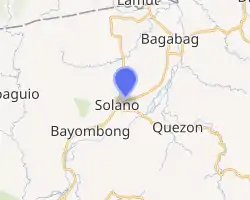Solano, Nueva Vizcaya
Solano, officially the Municipality of Solano (Gaddang: Ili na Solano; Ilocano: Ili ti Solano; Tagalog: Bayan ng Solano), is a 1st class municipality in the province of Nueva Vizcaya, Philippines. According to the 2015 census, it has a population of 59,517 people. [3].
Solano | |
|---|---|
| Municipality of Solano | |
 | |
 Flag  Seal | |
| Nickname(s): Commercial center of Nueva Vizcaya | |
 Map of Nueva Vizcaya with Solano highlighted | |
OpenStreetMap 
| |
.svg.png.webp) Solano Location within the Philippines | |
| Coordinates: 16°31′26″N 121°11′31″E | |
| Country | |
| Region | Cagayan Valley (Region II) |
| Province | Nueva Vizcaya |
| District | Lone district |
| Founded | October 7, 1741 |
| Barangays | 22 (see Barangays) |
| Government | |
| • Type | Sangguniang Bayan |
| • Mayor | Eufemia A. Dacayo |
| • Vice Mayor | Atty. Philip Dacayo |
| • Governor | Carlos M. Padilla |
| • Electorate | 38,963 voters (2019) |
| Area | |
| • Total | 139.80 km2 (53.98 sq mi) |
| Elevation | 273 m (896 ft) |
| Population | |
| • Total | 59,517 |
| • Density | 430/km2 (1,100/sq mi) |
| • Households | 15,236 |
| Economy | |
| • Income class | 1st municipal income class |
| • Poverty incidence | 6.57% (2015)[4] |
| • Revenue | ₱205,937,426.16 (2016) |
| Time zone | UTC+8 (PST) |
| ZIP code | 3709 |
| PSGC | |
| IDD : area code | +63 (0)78 |
| Climate type | tropical rainforest climate |
| Native languages | Gaddang Ilocano Tagalog |
| Website | www |
According to the 2016 Cities and Municipalities Competitiveness Index conducted by the National Competitiveness Council, Solano took the 25th spot overall and ranked 30 among the first class and second class municipalities in the Philippines. This further solidified the status of Solano as the undisputed premier town of Cagayan Valley.
Solano, being the fastest-growing municipality in the region, is slated to become Cagayan Valley Region's 5th City after Tuguegarao, Santiago, Cauayan, and Ilagan.
History
In 1760, the original name of the town was Bintauan, then a Gaddang settlement. The municipality was founded in 1767 by Father Alejandro Vidal, a Dominican priest who led a Spanish mission. In 1768, it was called Lungabang, from the Gaddang word for "cave". The name was later changed to Lumabang by the Spaniards for convenience. In 1851, Governor General Antonio Urbiztondo declared Lumabang a barrio of Bayombong for not having sufficient inhabitants and revenue to maintain itself. Governor General Ramon Solano y Llanderal authorized the separation of Lumabang as barrio from Bayombong. In 1853, the first Ilocanos arrived, brought by Don Diego Lumicao, a former gobernadorcillo. In 1889, it was renamed Solano, in honor of Governor General Ramon Solano y Llanderal.
The town was planned by Father Juan Villaverde, and the poblacion, as designed, consisted of 14 parallel wide streets, each having a width of 20 meters. Streets run from north to south and east to west, forming 100 square blocks with an aggregate area of one hectare per block. Solano was the largest municipality in the province until two of its barangays, Caliat and Bintawan, were segregated to become the municipalities of Quezon and Villaverde respectively. The land area of Solano was correspondingly reduced to 13,980 hectares. In 1957, the barrios of Ibung and Bintawan were separated to form the town of Ibung,[5] later renamed as Villaverde.
Barangays
Solano is politically subdivided into 22 barangays
- Aggub
- Bagahabag
- Bangaan
- Bangar
- Bascaran
- Communal
- Concepcion (Calalabangan)
- Curifang (Sinafal)
- Dadap
- Lactawan
- Osmeña (Urban)
- Pilar D. Galima
- Poblacion North (Urban)
- Poblacion South (Urban)
- Quezon (Urban)
- Quirino (Urban)
- Roxas (Urban)
- San Juan
- San Luis
- Tucal
- Uddiawan
- Wacal
Demographics
| Year | Pop. | ±% p.a. |
|---|---|---|
| 1903 | 5,624 | — |
| 1918 | 7,563 | +1.99% |
| 1939 | 17,878 | +4.18% |
| 1948 | 19,840 | +1.16% |
| 1960 | 22,523 | +1.06% |
| 1970 | 27,032 | +1.84% |
| 1975 | 33,036 | +4.10% |
| 1980 | 36,710 | +2.13% |
| 1990 | 44,246 | +1.89% |
| 1995 | 46,945 | +1.12% |
| 2000 | 52,391 | +2.38% |
| 2007 | 56,244 | +0.98% |
| 2010 | 56,134 | −0.07% |
| 2015 | 59,517 | +1.12% |
| Source: Philippine Statistics Authority [3] [6] [7][8] | ||
Local government

Spanish-era heads of government
Under the Spanish regime, Solano (then Bintauan) was ruled by a gobernadorcillo, which was elected by the cabezas de barangay (barangay heads) which represented the survival of the earlier tribal organizations and were responsible for the tributes of their groups. The cabezas were originally hereditary, but, in time, it became elective. The electors of the gobernadorcillo were current or former heads of the barangay and after 3 years of service became eligible for the office.
The following list shows the gobernadorcillos, who had the honorary title "Don", during the Spanish regime from 1762-1898.[9]
The following served as capitán del pueblo:
- 1762 Gatan
- 1763 Alianggang
- 1764 Danao Baccajan
- 1765 Alianggang
- 1766 Tomas Abbacan
- 1767 Felix Cadangan Sr.
- 1768 Antonio Binaley
- 1769 Sebastian Telan
- 1770 Domingo Buseg
- 1771 Luis Abbacan
- 1772 Mateo Guiguing
- 1773 Domingo Buseg
- 1774 Vicente Labog
- 1775 Bartolomé Bengao
- 1776 Bartolomé Bengao
- 1777 Luis Abbacan
- 1778 Santiago Dumelod
The next three years, the town head was to be known gobernadorcillo, and the position of capitan del pueblo was abolished.
- 1779 Antonio Dayag
- 1780 Vicente Labog
- 1781 Francisco Busa
The following served as alcaldes de naturales:
- 1782 Manuel Balassu
- 1783 Pedro Arasa
- 1784 Tomas Abbacan
- 1785 Clemente Malenab
- 1786 Tomas Lauagan
- 1787 Domingo Dumelod
- 1788 Santiago Agguid
On April 19, 1789, the alcalde mayor [of Cagayan] conveyed to the people the decree issued by the King of Spain ordering the restoration of the title gobernadorcillo.
- 1789 Pablo Saquing
- 1790 Domingo Panganiban
- 1791 Domingo Panganiban
- 1792 Domingo Dumelod
- 1793 Francisco Furuc Binaley
- 1794 Domingo Panganiban
- 1795 Vicente Labog
- 1796 Domingo Panganiban
- 1797 Raymundo Dinahum
- 1798 Vicente Pisang
- 1799 Domingo Panganiban
- 1800 Francisco Furuc Binaley
- 1801 Miguel Loggan
- 1802 Raymundo Dinahum
- 1803 Alberto Danguilan
- 1804 Miguel Mamuric
- 1805 Domingo Panganiban
- 1806 Jacinto Balauag
- 1807 Miguel Loggan
- 1808 Raymundo Dinahum
- 1809 Jacinto Balauag
- 1810 Vicente Pisang
- 1811 Jacinto Balauag
- 1812 Martín Lumicao
- 1813 Nicolás Alindayu
- 1814 Simon Danguilan
- 1815 Clemente Danguilan
- 1816 Antonio Danguilan
- 1817 Simon Danguilan
- 1818 Felipe Paracad
- 1819 Miguel Loggan
- 1820 Alejandro Cumiding
- 1821 Raymundo Dinahum
- 1822 José Pisang
- 1823 Antonio Danguilan
- 1824 Martín Lumicao
- 1825 Vicente Loggan
- 1826 Manuel Siggacao
- 1827 Martín Lumicao
- 1828 José Pisang
- 1829 Juan Guiab
- 1830 Miguel Panganiban
- 1831 Domingo Dinahum
- 1832 Clemente Danguilan
- 1833 José Pisang
- 1834 Jacinto Balauag
- 1835 Vicente Loggan
- 1836 Domingo Dinahum
- 1837 Clemente Danguilan
- 1838 Miguel Panganiban
- 1839 Ambrosio Loggan
- 1840 Enrique Balauag
- 1841 Dionisio Piggangay
- 1842 Clemente Danguilan
- 1843 José Pisang
- 1844 Justo Danguilan
- 1845 Domingo Dinahum
- 1846 Ambrosio Loggan
- 1847 Pedro Panganiban
- 1848 Diego Lumicao
- 1849 Enrique Balauag
- 1850 Pedro Panganiban
By executive order of 1851, Governor-General Antonio Urbiztondo, Marques de la Solana, declared Lumabang as a barrio of Bayombong, resulting in the office of gobernadorcillo becoming teniente del barrio.
- 1850 Gobernadorcillo Pedro Panganiban
- 1851 Teniente del Barrio Manuel Cutaran
- 1852 Teniente del Barrio Manuel Cutaran
- 1853 Teniente del Barrio Francisco Panganiban
- 1854 Teniente Del Barrio Félix Cadangan Jr.
- 1855 Teniente Del Barrio Florentino Valenciano
- 1856 Teniente Del Barrio Ambrosio Loggan
It was during this time when a new province, Isabela, was created, carving a portion of Nueva Vizcaya and a part of Cagayan. The new province was named in honor of Queen Isabella of Spain. The Governor of Nueva Vizcaya was Julian del Valle. The alcalde mayor of Cagayan came here for the purpose of this reorganization.
- 1857 Venido Loggan
- 1858 Domingo Esguerra
- 1859 Miguel Dumelod
- 1860 Miguel Loggan
General Ramon Solano y Llanderal authorized the separation of Lumabang as a barrio from Bayombong restoring the title of gobernadorcillo to Solano. From 1864, the term limit of the gobernadorcillo was extended from one year to two years
- 1860 Miguel Loggan
- 1861 Pedro Panganiban
- 1862 Enrique Balauag
- 1863 Venido Loggan
- 1864-65 Francisco Panganiban
- 1866-67 Vicente Saquing
- 1868-69 Santiago Ludan
- 1870-71 Miguel Loggan
- 1872-73 Francisco Panganiban
- 1874-75 Vicente Loggan
- 1876-77 Vicente Danguilan
- 1878-79 Francisco Panganiban
- 1880-81 Vicente Loggan
- 1882-83 Jacinto Loggan
- 1884 Francisco Binaley (died in office March 28, 1884)
- 1884-85 Antonio Dumelod
- 1886-87 Domingo Panganiban
- 1888-89 Domingo Ludan
In 1890, the establishment of the office of the justice of the peace was inaugurated in all the towns, and the first to assume this office in Solano was Domingo Panganiban who was in turn succeeded by Juan Sobrino, a Spaniard. who was succeeded by Sebastián Panganiban. who was then succeeded by Domingo Panganiban who held this office till 1898.
- 1890 Justice of the Peace Domingo Panganiban
- 1890 Justice of the Peace Juan Sobrino
- 1890 Justice of the Peace Sebastián Panganiban
- 1890-98 Justice of the Peace Domingo Panganiban
- 1890-91 Gobernadorcillo Antonio Dumelod
- 1892-93 Gobernadorcillo Domingo Loggan (replaced by Fernando Aggabao)
- 1894-95 Gobernadorcillo Sebastian Panganiban
It was during this time when the Royal Decree of the Central Government came, stopping the use of the title gobernadorcillo and in its stead capitán municipal was to be used. When Spanish colonial rule ended September 14, 1898, Solano was led by a teniente mayor.
- 1896-97 Capitán Municipal Sebastián Panganiban
- 1898 Teniente Mayor Felipe Lumicao
Mayors [10]
- 1899 Pedro Piggangay
- 1900 Herminigildo P. Soto
- 1901 Felipe Lumicao
- 1901 Pio Romero
- 1903-1909 Joaquín Velasquez
- 1910-1911 Lorenzo Manat
- 1912-1913 Justo Baniqued
- 1914-1915 Justo Balonkita
- 1916-1917 Doroteo Mondala
- 1918-1919 Joaquín Alayu
- 1920-1923 Julian Pinaroc
- 1923-1925 Tomas Lumicao
- 1926-1928 Pelomeno Sansano
- 1929-1931 Patricio Castillo
- 1932-1934 Mariano del Fiesta
- 1935-1938 Herminigildo P. Soto
- 1939-1940 Rufo Paras
- 1941 Nicomedes Castillo
- 1942 Victor Bobila
- 1943 Amado Logan
- 1944 Mariano del Fiesta
- 1945-1948 Domingo Lorenzo
- 1952-1954 José Espino
- 1955 Leodovico Pascial
- 1956-1963 Antonio Tottoc
- 1964-1966 Santiago M. Hermoso
- 1966-1967 Arsenio C. Lapitan
- 1968-1976 Osias D. Cadiente
- April 1976-April 1986 Pedro M. Tiongson
- April 1986-April 1987 Epifanio LD. Galima Jr.
- December 1987-February 1988 Roberto A. Balonkita
- February 1988-March 1992 Epifanio LD. Galima Jr.
- March 1992-June 1992 Menardo S. MERCADO
- July 1992-June 1998 Heraldo D. Dacayo
- July 1998-June 2001 Epifanio LD. Galima Jr.
- July 2001-May 2004 Heraldo D. Dacayo
- May 2004-June 2004 Wilson D. Salas
- July 2004-June 2007 Santiago O. Dickson
- July 2007-June 2016 Philip A. Dacayo
- July 2016-present Eufemia A. Dacayo
Economy
Solano is the main commercial and financial center of Nueva Vizcaya. It also has the most number of fast food restaurants in the province, including Jollibee, Greenwich Pizza, McDonald's, KFC, Chowking, Mang Inasal, Red Ribbon, Goldilocks and more. Solano has the most number of banks among the municipalities in the entire region with 25 banks. Major banks such as Metrobank, Banco de Oro, Bank of the Philippine Islands, Philippine National Bank, Landbank, Rizal Commercial Banking Corporation, China Bank as well as rural and regional banks are based here.
Tourism
- Hero's Park
- Solano Museum (SLS Compound)
- Ricanitas Cafe and Book store
- PLT Wellness and Resort
- Highlander Resort, Fastfood and Hotel
- Uddiawan - Communal Falls
- Balai Gloria Garden Resort
- World War II Cannon Relic
- Giant Butaka (in front of the St. Louis Beltran Church)
- St. Louis Beltran Church
- Bell Tower and Poong Itim Na Nazareno Shrine also called Quiapo of the North (Beside the Roman Catholic Church)
- Municipal Hall and garden
- Governors’ Garden Hotel
Festival
- The town's Pagbiagan Festival is celebrated every year of October 11. It coincides with Solano's Founding Anniversary, as well as the feast day of the town's patron Saint Louis Beltran.
Media
Solano is served by these radio stations.
AM stations
- DWMG 819 kHz (Vanguard Radio Network)
FM stations
- DWDC 101.3 Big Sound FM (Vanguard Radio Network)
- DWNV 100.5 (Rural Airwaves Media Services-Unified Airwaves Network)
Education
Universities, colleges, and vocational schools
- Aldersgate College
- Solano Institute of Technology
- Nueva Vizcaya Caregiver Academy
- Niño Jesus de Praga Learning, Inc.
- Cagayan Valley Maritime Studies, Inc.
- Fuzeko Polytechnic College
- Kids Workshop Learning Center
- Isaiah Christian Academy
High Schools
- Aldersgate College - High School Department
- Solano High School
- Saint Louis School - High School Department
- Dalton High School
- Uddiawan National High School
- Bascaran National High School
Elementary schools
- Solano East Central School
- Solano South Central School
- Solano North Elementary School
- Solano West Elementary School
- Aggub Elementary School
- Bangaan Elementary School
- Bangar Elementary School
- Bascaran Central School
- Concepcion Elementary School
- Curifang Elementary School
- Dadap Elementary School
- Lactawan Elementary School
- San Juan Elementary School
- San Luis Elementary School
- Tucal Elementary School
- Uddiawan Elementary School
- Wacal Elementary School
- Bagahabag Elementary School
- Pilar D. Galima Elementary School
- Saint Louis School - Elementary Department
- Aldersgate College - Elementary Department
References
- Municipality of Solano | (DILG)
- "Province: Nueva Vizcaya". PSGC Interactive. Quezon City, Philippines: Philippine Statistics Authority. Retrieved 12 November 2016.
- Census of Population (2015). "Region II (Cagayan Valley)". Total Population by Province, City, Municipality and Barangay. PSA. Retrieved 20 June 2016.
- "PSA releases the 2015 Municipal and City Level Poverty Estimates". Quezon City, Philippines. Retrieved 1 January 2020.
- "An Act Creating the Municipality of Ibung, Province of Nueva Vizcaya". LawPH.com. Retrieved 2011-04-13.
- Census of Population and Housing (2010). "Region II (Cagayan Valley)". Total Population by Province, City, Municipality and Barangay. NSO. Retrieved 29 June 2016.
- Censuses of Population (1903–2007). "Region II (Cagayan Valley)". Table 1. Population Enumerated in Various Censuses by Province/Highly Urbanized City: 1903 to 2007. NSO.
- "Province of Nueva Vizcaya". Municipality Population Data. Local Water Utilities Administration Research Division. Retrieved 17 December 2016.
- Journals of Northern Luzon, St. Mary's University, Bayombong, 1972, pages 97–105
- https://nuevavizcaya.gov.ph/municipalities/solano/
External links
| Wikimedia Commons has media related to Solano, Nueva Vizcaya. |
| Wikivoyage has a travel guide for Solano (Philippines). |